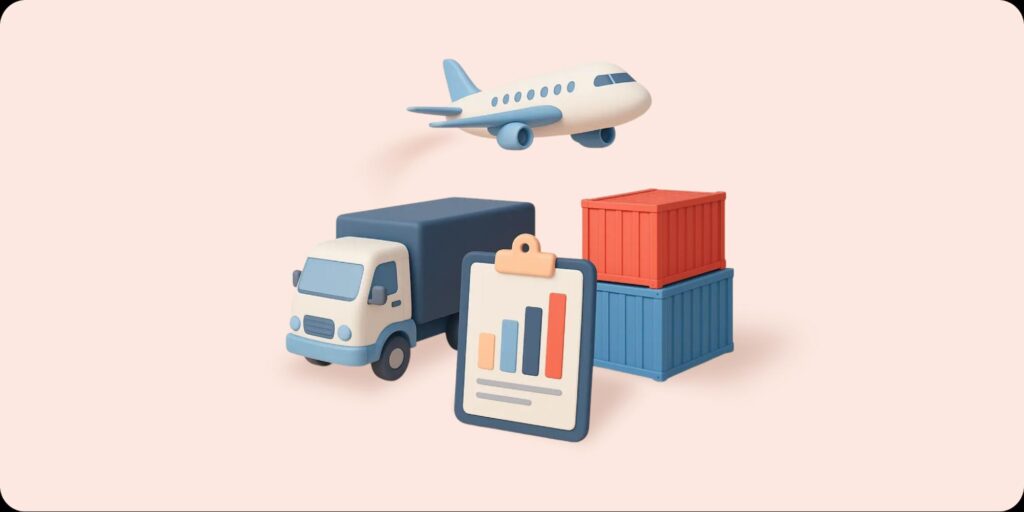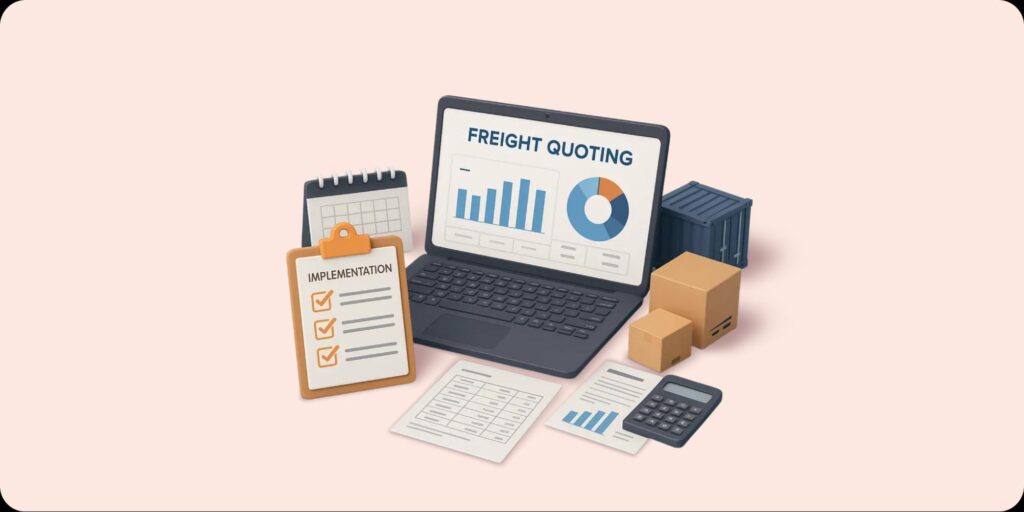Key Takeaways
- Use real-time data and predictive analytics to optimize routes, avoid cost spikes, and select the best lanes and carriers for each shipment.
- Consolidate loads, adopt multi-modal strategies, and ship off-peak to cut freight costs and improve efficiency across shipping operations.
- Standardize workflows, improve packaging/load planning, and train teams on cost compliance to unlock automation and reduce handling, documentation, and error-related costs.
- Leverage TMS, AI, and automated tools to audit invoices, benchmark carrier rates, and dynamically manage contracts and shipments for sustained savings.
- Wisor reduces freight costs by 85% with AI-powered rate shopping, invoice audits, real-time tracking, and seamless ERP/TMS integration, streamlining quoting, booking, and margin visibility in one platform.
Understanding Freight Costs
For most freight forwarders, reducing costs isn’t optional – it’s fundamental. However, today’s challenges go beyond traditional cost levers. Geopolitical instability, shifting lane dynamics, and highly volatile rates have added new layers of complexity. Even conventional drivers like fuel prices, carrier capacity, regulatory shifts, and evolving customer expectations still have a major impact.
Freight managers need to strike a careful balance between cost control and service quality, aligning with both CFO expectations and customer SLAs. That requires accurate forecasting across customer demand, rate trends, and market behavior.
Modern tools like real-time pricing data, integrated carrier communication, and automated cost analysis give forwarders the flexibility to adapt strategies instantly, switching modes or lanes to avoid cost spikes and stay competitive.
How to Reduce Freight Costs: Top 10 Strategies & Best Practices
While there’s no one-size-fits-all solution, freight forwarders can typically reduce freight costs by looking at data, leveraging modal flexibility, and using predictive analytics to score deals on freight in off-peak and off-season periods.
1. Optimize Shipping Routes with Real-Time Data
Historical trend data is undeniably critical to cost and route prediction. However, it often fails to account for real-time conditions that can quickly disrupt forecasts. For instance, relying on summer 2023 data to predict air cargo rates for 2024 would lead to severe cost mismatches due to rapid market shifts.
Historic data needs to be supplemented with real-time data including market position, real-world events, and market trends. These give insight into freight rates and behavior per corridor and mode, enabling smarter decisions for carrier and lane selection.
2. Consolidate Shipments to Maximize Load Efficiency
For forwarders with LTL shipments, load consolidation maximizes efficiency and reduces costs. This approach becomes even more effective when combined with strategies like zone skipping, where bulk freight is moved closer to the final delivery zone before being handed off to last-mile carriers.
Implementing shipping consolidation means managing real-time carrier and truck availability, so loads can be consolidated or even automatically moved onto the same carrier where needed.
3. Leverage Multi-Modal Transportation for Flexibility
Multi-modal and multicarrier transportation introduce flexibility into your lanes. For example, by using sea, truck, and rail, you can automatically select the right balance between cost and speed for each leg of a journey. When rates go up in one mode, such as air, you can look to reduce freight costs by moving to another mode for the same lane.
4. Ship During Off-Peak to Avoid Premium Charges
Plan freight shipments in advance to take advantage of non-peak rates. Earlier bookings typically mean lower rates, while allowing freight forwarders to align delivery times with seasonally lower rates. In addition, stepping away from notoriously unpredictable spot rates means costs are stable, delivering better insight into freight costs over the period.
5. Use Freight Tech (TMS, Automation, AI)
TMS and automation are quickly becoming essential tools for modern freight forwarders. A good transportation management system integrates with both carriers and shippers, while also offering documentation automation, intelligent carrier selection, and AI-powered analytics for cost control.
6. Benchmark Carrier Rates Regularly
Keeping tabs on market position can help forwarders select the best deal regardless of contracted rates. Spot rates are notoriously volatile, often changing daily or even hourly in fast-moving markets. Even contracted carrier rates may fluctuate every few months. Benchmarking contracted rates against spot rates and market demand delivers insight into opportunities for cost-savings.
7. Standardize Shipping Procedures Across Teams
Standardizing processes, documentation, and workflows across teams ensures consistency, visibility, and faster decision-making. Introducing it may take time; however, standardization introduces opportunities for automation, AI freight cost optimization, and eventually, freight efficiency. For example, time and cost savings in historically error-prone and costly processes like documentation, regulatory compliance, and quoting.
8. Improve Packaging and Load Planning to Minimize Wasted Space
Empty space is expensive. Implement load planning strategies to minimize waste space in trucks and containers, and therefore reduce freight costs. Good load planning includes packaging (accounting for fragility, temperature sensitivity, and handling), space availability, carrier restrictions, etc.
More importantly, load planning means aligning loading with carriers, so handling and onloading/offloading go as quickly and smoothly as possible. This reduces freight costs in other ways, such as by reducing harbor fees or minimizing wait, load, and congestion fees.
9. Lock in Long-Term Contracts with Reliable Carriers
Contract rates aren’t always the cheapest way to move freight. Given that carrier availability remains one of the biggest bottlenecks in freight, contracts can secure capacity at fixed rates, providing stability in volatile markets. After contract negotiation, use rate benchmarking solutions and utility management to ensure that carriers are not underutilized.
10. Train Teams on Cost Awareness and Freight Policy Compliance
Aligning teams on budget and cost factors greatly improves adherence to policies and cost reduction. When teams consistently apply practices like cost indexing and smart carrier selection, the result is measurable savings. That’s especially true when shipment consolidation and carrier coordination happen across departments. But to make it work, teams need shared knowledge, including how to use the same tools, workflows, and data insights, so operations stay aligned across the organization.
Expert Tip: Slash Freight Waste with These Data-First Tactics
- Set quarterly benchmarks across modes. Pull spot and contract rates by lane, then re-score every 90 days using real-time index data. This guards against margin erosion in fast-moving rate environments.
- Audit invoice and accessorials weekly. Use automated tools to flag hidden fees, wait time, liftgate, detention, then renegotiate with carriers showing frequent overages.
- Pre-plan multimodal switch points. When sea or air hits rate ceilings, know in advance which lanes can shift to rail or FTL. Build these alternatives into SOPs, not just ad hoc responses.
- Align load planning with real-time carrier availability. Centralize bookings to enable consolidation. If one forwarder team books FTL solo, you lose savings and capacity efficiency.

Insight by
Nimrod
VP R&D, Wisor
Why Reducing Freight Costs Matters: Key Benefits
A resilient shipping operation must adapt to market shifts and pricing fluctuations. Cost controls are a critical element of business sustainability. Here, forwarders position themselves to realize not only immediate cost-savings, but also long-term competitive advantages that extend across the supply chain.
- Boost Operational Efficiency: Standardized processes, software integrations, and inter-team and carrier communication are critical to reducing freight forwarder fees. At the same time, these steps introduce operational efficiencies that boost profitability across the organization.
- Improve Profit Margins: Cost savings enable competitive pricing or reinvestment into technologies and infrastructure that drive long-term growth.
- Increase Delivery Reliability: Building carrier and modal flexibility and reliable carrier contracts into processes introduces opportunities for cost reductions. It also means better flexibility and resource availability to offer reliable delivery to customers.
- Enhance Customer Experience: With standardized processes, automation, and reliable carriers, plus options to source competitive pricing, customers have a better experience.
Freight Cost Components to Monitor
By consistently monitoring and evaluating freight expenses, forwarders can proactively address inefficiencies. Leveraging data-driven insights from regular audits and transparent communication with carriers enables forwarders to react swiftly to market changes and avoid costly billing errors or unexpected surcharges.
| Freight Cost Components | Challenge | Best Practices |
| Base Freight Rates | Base freight rates can fluctuate considerably across carriers, modes, and lanes. | Monitor freight costs in real-time for automatic carrier, lane, and mode selection. |
| Fuel Surcharges/Indexes | Fuel surcharges can significantly inflate freight costs, often stacking on top of already negotiated carrier rates. | Monitor fuel indexes to predict added freight costs. |
| Freight Class/Dimensional Weight | Freight dimensions and weight vastly impact costs, especially in some transport modes. | Align freight with cost-effective modes, for example, moving large and heavy freight to rail to reduce freight costs. |
| Handling Costs | Handling, including packaging costs, can be extremely high, especially when handled by third parties. | Monitor actual costs and take packaging/handling in-house or switch to a 3PL wherever it reduces freight costs. |
| Accessorial & Hidden Charges | Lift gates, waiting time, congestion fees, etc., can sharply add to transportation costs. | Monitor real-world conditions and align with carriers to reduce wait, congestion, and loading fees. |
| Invoice Accuracy & Disputes | Invoicing mistakes and disputes cut into cashflow and profitability, even when actual issues are minor. | Leverage AI for automatic invoicing to reduce manual errors and see cost savings. |
Using Technology to Cut Freight Costs
Freight technology empowers forwarders to optimize decisions, enhance transparency, and control freight costs at every turn. Building a freight tech stack is now one of the basics of freight forwarding. TMS enables insight into real-time shipping location, carrier integrations, carrier availability, and resource availability. AI and machine learning introduce opportunities to identify trends and inefficiencies, automate manual processes, and underpin decision-making with real-time analytics.
For example, automatic rate comparison engines give forwarders unprecedented insight into actual costs per shipment in real time. Real-time analytics and dashboards ensure stakeholders have the data needed to make informed, timely decisions to select the most cost-effective carriers, anticipate surcharges and fees, and adapt to shifting market conditions per shipment.
Freight Sustainability Strategies that Save Freight Costs
While saving on freight costs is typically about improving margins through reduced shipping costs, strategies often align with sustainability goals as well. Forwarders aiming to improve margins can tap into sustainability strategies, such as using lighter packaging, consolidating deliveries, and optimizing route density, which also reduce costs.
- Using carrier and resource management to align shipments and reduce empty miles to reduce carbon emissions and decrease freight shipping costs.
- Consolidated LTL shipments to reduce emissions and costs per freight unit
- Lightweight packaging to reduce freight volume (and carbon footprint)
For most forwarders, cost reduction strategies will remain key. However, green initiatives often align very well with cost-savings strategies. Balancing the two can enable meeting changing customer and regulatory expectations while achieving desired margin increases.
Good to Remember
Relying on historical rate data alone can underprice your quotes, real-time data is key to avoiding profit-killing rate mismatches.
How to Implement and Sustain a Freight Cost Reduction Plan in 6 Steps
Driving long-term cost savings requires operational change. Introducing a continuous improvement loop where teams regularly analyze performance data and apply insights helps uncover hidden inefficiencies and improve over time. Freight managers should regularly review internal and external freight operations, leverage digital tools, and integrate real-time data and benchmarks into processes.
This integrated approach uncovers hidden inefficiencies while enabling agile responses to market shifts, regulatory changes, and fluctuating rates. Ultimately, a well-orchestrated freight operations strategy empowers forwarders to maximize value from every dollar spent.
1. Conduct a Freight Audit
Conduct an initial audit to benchmark freight costs, carrier rates, reliability, lane selection, etc. Then, adopt a proactive approach that combines technology, negotiation, and process optimization moving forward. Adopt processes, technologies, and carriers to fill gaps and then optimize.
By systematically evaluating carrier performance and integrating freight shipping cost comparison tools, freight forwarders can automatically uncover the best options for each shipment and adjust strategies on the fly.
2. Negotiate Carrier Contracts
Refer to historic data and benchmarks for carrier utilization as well as expected transportation costs. Then, negotiate contracts with your most reliable carriers to ensure carrier availability. After negotiation, it’s important to introduce freight contract management. For example, using AI to monitor performance and utilization over the duration of the contract.
Contracts should be treated as strategic assets, leveraged where they offer advantages, whether in securing better rates or fulfilling minimum volume commitments.
3. Set Up Automated Rate Shopping
Benchmark carrier rates, integrate carrier rate sheets with freight shipping costs, and maintain a single database with all carrier resources. Then, use digital tooling to automatically compare quotes and rates per lane and mode, for automatic rate selection.
Of course, automated rate shopping can be complex when using intermodal carriers. Even the TEU/FEU rate can vary significantly. Linking to indexes and using AI to analyze freight shipping costs ensures opportunities are visible.
4. Use TMS With Real-Time Visibility
Real-time visibility into truckloads, resources, and shipments creates opportunities for process optimization. For example, teams can consolidate loads. A transportation management system introduces opportunities for better communication with carriers, reducing wait times and accessory costs. Real-time visibility into shipment locations enables better communication with customers and other carriers at handoffs, creating a seamless experience for everyone.
5. Audit Invoices Automatically
Invoice errors can introduce costly losses and slow cashflow. Introducing invoice audits into the process removes those risks. For most, automated invoice generation coupled with manual audit is the most efficient way to go.
6. Monitor KPIs With Dashboards
Modern freight tech offloads complex analytics and calculations to AI, freeing up teams to focus on strategic decisions. At the same time, key people still need data ranging from market positioning to carrier reliability trends and real-time shipment location. Set KPIs, build dashboards for each team or department, and ensure the right people have options to view data they need to make decisions.
How Wisor Helps You Reduce Freight Costs
Wisor reduces freight and shipping costs by eliminating manual work and optimizing every stage of the quoting and booking process. Here’s how:
- AI-Driven Rate Shopping and Booking: Pull from indexes and carrier rate cards to instantly compare and select the best carrier options to optimize freight costs in real time.
- Dynamic Route and Mode Optimization: Automatically compare rates, real-world factors like congestion, and freight requirements to identify the most efficient and cost-effective route and mode in real time.
- Automated Freight Invoice Audits: Catch hidden charges, invoice errors, and overbilling with specialized freight audit services.
- Real-Time Tracking and Alerts: Improve shipment visibility and introduce communication with carriers and customers to avoid costly delays and reduce shipping costs.
- Integrated Carrier and Cost Visibility: Get centralized insights into carrier performance, fuel costs, and margin per shipment.
- Seamless ERP and TMS Integrations: Reduce administrative overhead and streamline workflows with existing shipper and carrier systems.
Conclusion
Ultimately, freight cost reduction lies in ongoing innovation, team and carrier collaboration, and adoption of emerging technologies like AI, real-time data feeds, and automation. By fostering a culture of continuous improvement and staying attuned to evolving industry best practices, forwarders can proactively address rising operational expenses and shifting market demands. Embracing freight technologies enhances resilience, empowering logistics teams to navigate disruptions, exceed customer expectations, and sustain long-term profitability.
Want to see how Wisor streamlines freight quoting, rate shopping, mode optimization, and analytics, all in one platform? Let’s schedule a demo!






